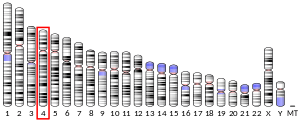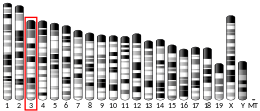BMPR1B
Bone morphogenetic protein receptor type-1B also known as CDw293 (cluster of differentiation w293) is a protein that in humans is encoded by the BMPR1B gene.[5][6]
Function
BMPR1B is a member of the bone morphogenetic protein (BMP) receptor family of transmembrane serine/threonine kinases. The ligands of this receptor are BMPs, which are members of the TGF-beta superfamily. BMPs are involved in endochondral bone formation and embryogenesis. These proteins transduce their signals through the formation of heteromeric complexes of 2 different types of serine (threonine) kinase receptors: type I receptors of about 50-55 kD and type II receptors of about 70-80 kD. Type II receptors bind ligands in the absence of type I receptors, but they require their respective type I receptors for signaling, whereas type I receptors require their respective type II receptors for ligand binding.[7]
The BMPR1B receptor plays a role in the formation of middle and proximal phalanges.[8]
Clinical significance
Mutations in this gene have been associated with primary pulmonary hypertension.[7]
In the chick embryo, it has been shown that BMPR1B is found in precartilaginous condensations.[9] BMPR1B is the major transducer of signals in these condensations as demonstrated in experiments using constitutively active BMPR1B receptors.[9] BMPR1B is a more effective transducer of GDF5 than BMPR1A.[9] Unlike BMPR1A null mice, which die at an early embryonic stage, BMPR1B null mice are viable.[9]
References
- GRCh38: Ensembl release 89: ENSG00000138696 - Ensembl, May 2017
- GRCm38: Ensembl release 89: ENSMUSG00000052430 - Ensembl, May 2017
- "Human PubMed Reference:". National Center for Biotechnology Information, U.S. National Library of Medicine.
- "Mouse PubMed Reference:". National Center for Biotechnology Information, U.S. National Library of Medicine.
- ten Dijke P, Yamashita H, Ichijo H, Franzén P, Laiho M, Miyazono K, Heldin CH (April 1994). "Characterization of type I receptors for transforming growth factor-beta and activin". Science. 264 (5155): 101–4. doi:10.1126/science.8140412. PMID 8140412.
- Ide H, Saito-Ohara F, Ohnami S, Osada Y, Ikeuchi T, Yoshida T, Terada M (1998). "Assignment of the BMPR1A and BMPR1B genes to human chromosome 10q22.3 and 4q23-->q24 byin situ hybridization and radiation hybrid map ping". Cytogenet. Cell Genet. 81 (3–4): 285–6. doi:10.1159/000015048. PMID 9730621.
- "Entrez Gene: bone morphogenetic protein receptor".
- Mishina Y, Starbuck MW, Gentile MA, Fukuda T, Kasparcova V, Seedor JG, Hanks MC, Amling M, Pinero GJ, Harada S, Behringer RR (2004). "Bone morphogenetic protein type IA receptor signaling regulates postnatal osteoblast function and bone remodeling". J. Biol. Chem. 279 (26): 27560–6. doi:10.1074/jbc.M404222200. PMID 15090551.
- Yoon BS, Ovchinnikov DA, Yoshii I, Mishina Y, Behringer RR, Lyons KM (2005). "Bmpr1a and Bmpr1b have overlapping functions and are essential for chondrogenesis in vivo". Proc. Natl. Acad. Sci. U.S.A. 102 (14): 5062–7. doi:10.1073/pnas.0500031102. PMC 555995. PMID 15781876.
External links
- BMPR1B+protein,+human at the US National Library of Medicine Medical Subject Headings (MeSH)
- Human BMPR1B genome location and BMPR1B gene details page in the UCSC Genome Browser.
This article incorporates text from the United States National Library of Medicine, which is in the public domain.



